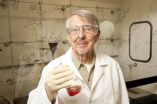(Press-News.org) WEST LAFAYETTE, Ind. - A Purdue University research team developed a nanoparticle that can hold and release an antimicrobial agent as needed for extending the shelf life of foods susceptible to Listeria monocytogenes.
Yuan Yao, an assistant professor of food science, altered the surface of a carbohydrate found in sweet corn called phytoglycogen, which led to the creation of several forms of a nanoparticle that could attract and stabilize nisin, a food-based antimicrobial peptide. The nanoparticle can then preserve nisin for up to three weeks, combating Listeria, a potentially lethal foodborne pathogen found in meats, dairy and vegetables that is especially troublesome for pregnant women, infants, older people and others with weakened immune systems.
Controlling Listeria at deli counters, for example, is especially problematic because meat is continually being opened, cut and stored, giving Listeria many chances to contaminate the food. Nisin alone is only effective at inhibiting Listeria for a short period - possibly only a few days - in many foods.
"People have been using nisin for a number of years, but the problem has been that it is depleted quickly in a food system," said Arun Bhunia, a Purdue professor of food science who co-authored a paper with Yao on the findings in the early online version of the Journal of Controlled Release. "This nanoparticle is an improved way to deliver the antimicrobial properties of nisin for extended use."
Yao used two strategies to attract nisin to the phytoglycogen nanopoarticles. First, he was able to negatively charge the surface of the nanoparticle and use electrostatic activity to attract the positively charged nisin molecules. Second, he created a partially hydrophobic condition on the surface of the nanoparticle, causing it to interact with partially hydrophobic nisin molecules. When the particles are hydrophobic, or repel water, they become attracted to each other.
"Both strategies may work together to allow nanoparticles to attract and stabilize nisin," Yao said, "This could substantially reduce the depletion of nisin in various systems."
For practical use, Yao said a solution containing the nanoparticles and free nisin could be sprayed onto foods or included in packaging. The solution requires a balance of free nisin and nisin on the nanoparticles.
"When you reduce the amount of free nisin, it will trigger a release of more nisin from the nanoparticles to re-establish the equilibrium," Yao said. "There will be a substantial amount of nisin preserved to counteract the Listeria."
Using a model, Yao said a sufficient amount of nisin to combat Listeria could be preserved for up to 21 days.
Yao and his colleagues are working on using other food-based antimicrobial peptides and nano-constructs to combat Listeria other foodborne pathogens such as E. coli O157:H7 and salmonella. The U.S. Department of Agriculture and the National Science Foundation funded their research.
INFORMATION:
Writer: Brian Wallheimer, 765-496-2050, bwallhei@purdue.edu
Sources: Yuan Yao, 765-494-6317, yao1@purdue.edu
Arun Bhunia, 765-494-5443, bhunia@purdue.edu
Abstract on the research in this release is available at: http://www.purdue.edu/newsroom/research/2010/101207YaoNisin.html
END
Investigators at Southern Methodist University and The University of Texas at Dallas have discovered a family of small molecules that shows promise in protecting brain cells against nerve-degenerative diseases such as Parkinson's, Alzheimer's and Huntington's, which afflict millions.
Dallas-based startup EncephRx, Inc. was granted the worldwide license to the jointly owned compounds. A biotechnology and therapeutics company, EncephRx will develop drug therapies based on the new class of compounds as a pharmaceutical for preventing nerve-cell damage, delaying onset of ...
SEATTLE & CHICAGO – Scientists at Seattle Biomedical Research Institute (Seattle BioMed) and Northwestern University Feinberg School of Medicine have reached a major milestone in the effort to wipe out some of the most lethal diseases on the planet. As leaders of two large structural genomics centers, they've experimentally determined 500 three-dimensional protein structures from a number of bacterial and protozoan pathogens, which could potentially lead to new drugs, vaccines and diagnostics to combat deadly infectious diseases. Some of the structures solved by the centers ...
A school-based intervention program designed for adolescents with asthma significantly improves asthma management and quality of life for the students who participate, and reduces asthma morbidity, according to researchers in New York City, who studied the effect of the program aimed at urban youth and their medical providers. The Asthma Self-Management for Adolescents (ASMA) program is an eight-week intervention geared toward helping adolescents learn more effective ways of managing their symptoms and controlling their asthma.
The findings were published online ahead ...
New Rochelle, NY, December 7, 2010—Genetic Engineering & Biotechnology News (GEN) recently co-sponsored a roundtable discussion on new ways to use biological solutions to assist in environment clean-up after manmade or natural disasters. "Gulf Oil Spill: Using Modern-day Biology to Assess the Environmental Impact and to Help in Remediation" was also sponsored by the Venture Development Center (VDC) at The University of Massachusetts Boston, where the discussions took place. Part I of the roundtable appears on the Video Section of the GEN website (http://www.genengnews.com/video-channel) ...
EAST LANSING, Mich. --- While Asian carp, gypsy moths and zebra mussels hog invasive-species headlines, many invisible invaders are altering ecosystems and flourishing outside of the limelight.
A study by Elena Litchman, Michigan State University associate professor of ecology, sheds light on why invasive microbial invaders shouldn't be overlooked or underestimated.
"Invasive microbes have many of the same traits as their larger, 'macro' counterparts and have the potential to significantly impact terrestrial and aquatic ecosystems," said Litchman, whose research appears ...
Athens, Ga. – Researchers at the University of Georgia have discovered a central switch that controls whether cells move or remain stationary. The misregulation of this switch may play a role in the increased movement of tumor cells and in the aggressiveness of tumors themselves.
"Malignant cancer arises when cancer cells acquire the ability to move away from their primary tissue location," said Natalia Starostina assistant research scientist in the UGA department of cellular biology and lead author of the research. "The control of cell movement is a fundamental aspect ...
A new formulation of Amphotericin B (AmB) developed by University of British Columbia researchers has been shown to be stable in tropical climates and effective in treating Visceral Leishmaniasis (VL) in mouse models.
VL is a blood-born parasitic disease that afflicts 12 million people worldwide, mainly in developing countries and tropical regions. According to the World Health Organization (WHO), 1.5 million new cases of the disease are reported every year, and 60,000 people die from it.
AmB, a 50-year-old anti-fungal drug, is the standard treatment for VL, but its ...
(Garrison, NY) Practices for protecting human research subjects with Alzheimer's disease and other conditions that make them incapable of giving informed consent are widely variable and in need of more concrete ethical and legal guidance, according to a study in IRB: Ethics & Human Research.
The findings are significant for several reasons. First of all, the authors write, many countries have made research on dementia a national health priority and launched clinical trials that involve people who are, or are likely to become, cognitively impaired. These trials increasingly ...
CHAMPAIGN, Ill. – The lame-duck Congress may be the last chance for the current Democratic majority to slip through legislation legalizing online gambling, a move that could have dire consequences for communities and the economy, a leading national gambling critic warns.
Although much of the talk on Capitol Hill revolves around Bush-era tax cuts and reducing the deficit, University of Illinois business professor John W. Kindt says don't be surprised if a bill legalizing online gambling is floated by outgoing House Democrats under the auspices of revenue generation.
"The ...
COLUMBUS, Ohio – Many U.S. restaurants may be ignoring a desire by American consumers to dine at environmentally friendly restaurants, according to a small exploratory study.
Researchers found that more than 8 out of 10 restaurant patrons surveyed in Columbus said they would be willing to pay more to dine at "green" restaurants. More than 7 out of 10 said it was good for restaurants to protect the environment.
The only problem is that very few restaurants market themselves as "green" or environmentally friendly, said Jay Kandampully, co-author of the study and professor ...


